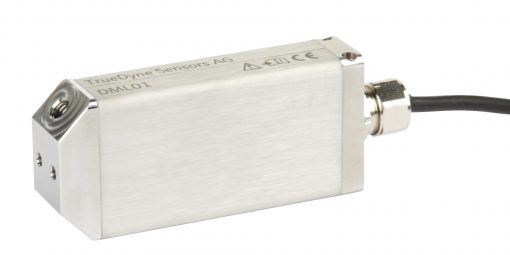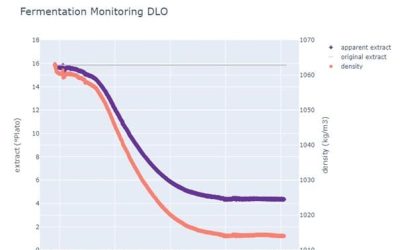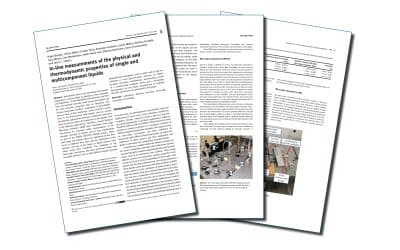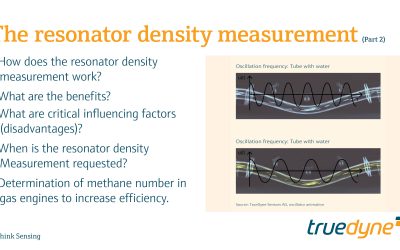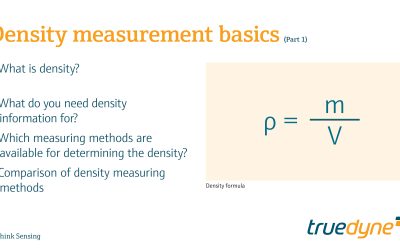Wink of knowledge: Brine Water Concentration Measurement – DLO Density Sensor
Volume 2 | Number 2
Why this test?
When taking measurements in boreholes for the extraction of salt, the concentration measurement poses a fairly large problem. In the case of saturated brine, even slight changes in the process lead to salt deposits, which will cause every measuring device to fail in the short or long term. With this test we wanted to show that it is possible to measure the concentration of brine with our DLO.
What is a wink of knowledge?
Do you sometimes need to measure, draw or do something quickly? The speed at which you get to the result counts more than the perfect (scientific) approach. For this reason, we introduced a wink of knowledge. Science with a wink, so to speak. Our aim is not to prove anything scientifically, but to quickly demonstrate something pragmatically. If you’re interested, we would be happy to discuss these results in more detail with you and your project.
What liquids were used?
Brine water at various concentrations:
- 26% brine
- 15% brine
Density measurement
The density was measured with the DLO-M1 density sensor for liquids. For this purpose, the listed concentrations were passed through the sensor at a constant flow rate. Using the logging function, a reading for density and temperature was logged every second.
Brine (26.1%)
1197.109 kg/m³
at 20 °C, 1.01325 bar abs
Brine (15%)
1108.9 kg/m³
at 20 °C, 1.01325 bar abs
The TrueDyne sensor
The DLO-M1 density sensor measures the density of a fluid in a microelectromechanical system (MEMS system). Inside the sensor, the medium is passed via a pressure gradient to the so-called omega chip, which contains an omega-shaped microchannel. This vibronic measuring system generates the measured values by setting a silicon tube in the chip into resonant vibration and analysing this. This is because the quality of the vibration depends on the viscosity of the liquid in the microchannel. At the same time – and independent of the viscosity – the density of the medium can be determined via the frequency of the microchannel. Since temperature influences both viscosity and density, the temperature of the medium is also recorded in real time in the chip. This way, the temperature effect can be compensated.
The measuring system in the submillimetre range enables the compact construction of the sensor. It is only 80 x 30 x 15 mm³ small and thus fits inside even the tightest of spaces. The readings reach the higher-level system via an RS232 interface and in the ASCII command protocol in the TrueDyne Sensors standard.
Test setup
- Determination of density at 20 °C with laboratory density meter DSA 5000 M (Anton Paar)
- Insert the density sensor into the measurement setup as shown in the picture
- Circulation system with pump set up for measuring brine concentration
Measurement setup
- Starting materials: NaCi and water
- Bottle: NaCi water at various concentrations
- Peristaltic pump (Ismatec, ISM930C)
- DLO density sensor
- Data evaluation
- Return of the medium
Results
After a short time, the saturated brine also caused drifts in our sensor (Figure 2). This is, of course, not a satisfactory solution for continuous measurement. Due to the small measuring volume in our sensor, we came up with the right idea: we dilute the brine with pure water and then calculate back to get the total volume. The flow rate is measured or controlled with our own Coriolis sensors for the smallest flow rates. With a reduction in salinity of <15%, the initial drifts could be eliminated, allowing continuous measurement (Figure 3).
How can this now be implemented in practice? If the flow rate of the fresh water supply and the total volume at the outlet are measured, the concentration can be determined very accurately using a linear function (Figure 4). Due to the lower salt content, drifts also no longer occur, which enables long-term measurement in the field. The slight deviation in Figure 4 is due to the measurement setup. This allowed water to evaporate over the long measurement period (which is why the proportion of NaCl in the concentration increases).
Sensors that might interest you
Gases
Viscosity
Applications that might interest you
Other articles that might interest you
Wink of Knowledge: smart mass flow controller
Discover the future of precise gas flow control with the innovative Smart Mass Flow Controller from TrueDyne Sensors AG. In cooperation with IST AG, we have developed a pioneering device capable of measuring density, temperature, pressure and mass flow – all in one sensor. Designed for flexibility and accuracy, this controller automatically adapts to different pure gases and binary gas mixtures, ensuring optimal performance. Learn more about this groundbreaking solution at TrueDyne Sensors AG.
Wink of Knowledge: Monitoring the beer fermentation process via density and CO2 formation
Density and CO2 formation were measured during the fermentation process. The measurements of the wort’s density, degree of fermentation and alcohol content agree very well with expectations and verification measurements with laboratory equipment. The presented solution enables automatable, continuous monitoring of the process as well as determination of …
Wink of Knowledge: Measurement of the hydrogen peroxide concentration in water with <0.025% measurement uncertainty
Density measurements of hydrogen peroxide in water with the VLO-M2 were correct within <0.05 kg/m3 using control measurements from a laboratory analyser. The measured deviations correspond to a measurement uncertainty of <0.025% (250ppm) for the concentration determination.
Article: In-line measurements of the physical and thermodynamic properties of single and multicomponent liquids
Microfluidic devices are becoming increasingly important in various fields of pharmacy, flow chemistry and healthcare. In the embedded microchannel, the flow rates, the dynamic viscosity of the transported liquids and the fluid dynamic properties play an important role. Various functional auxiliary components of microfluidic devices such as flow restrictors, valves and flow meters need to be characterised with liquids used in several microfluidic applications.
Wink of Knowledge: Thermal flow measurement and correction by means of gas detection
Flow sensors based on the calorimetric measuring principle typically have to be adjusted to a specific medium. This wink of knowledge shows that a real-time density measurement is highly suitable for correcting the measured flow value for pure gases as well as binary gas mixtures.
Article: Design, Simulation, Fabrication and Characterization of piezoelectric MEMS Cantilever for Gas Density and Viscosity Sensors Applications
Design, Simulation, Fabrication and...
Article: Multiparameter Gas-Monitoring System
The aim of the study is to develop a compact, robust and maintenance free gas concentration and humidity monitoring system for industrial use in the field of inert process gases. Our multiparameter gas-monitoring system prototype allows the simultaneous measurement of the fluid physical properties (density, viscosity) and water vapor content (at ppm level) under varying process conditions.
Part 3 – MEMS technology
MEMS technologyAt a glance In the previous...
Part 2 – The resonator density measurement
The resonator density measurement At a glance In...
Part 1 – Density measurement basics
Density measurement basics At a glance This...

